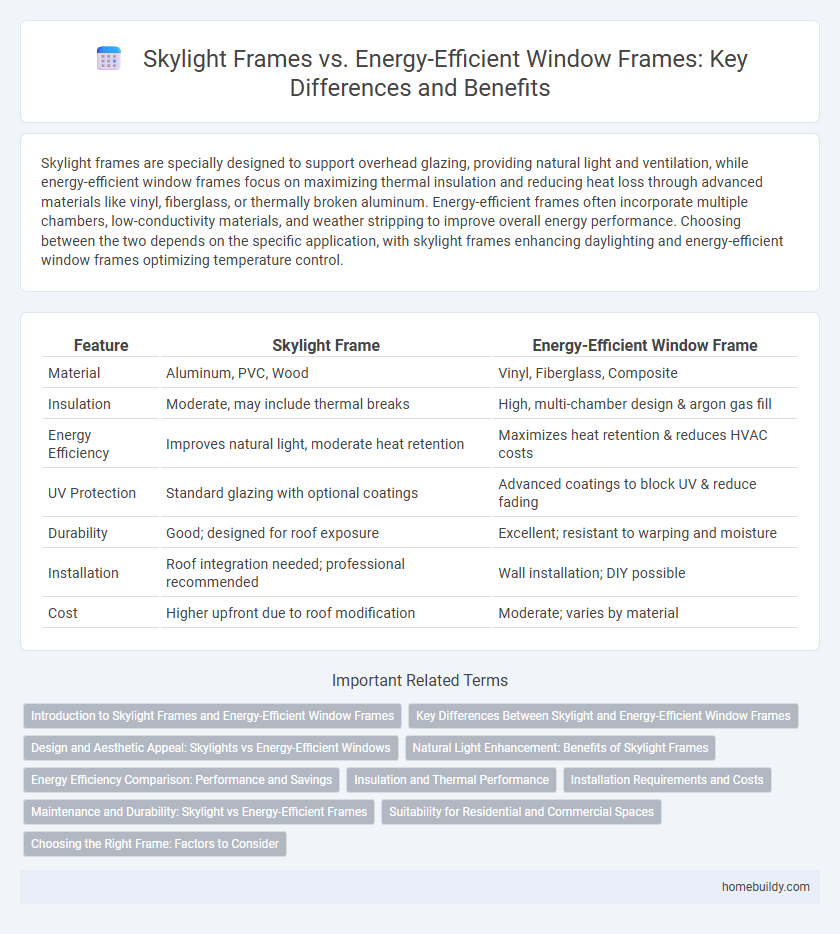Skylight frames are specially designed to support overhead glazing, providing natural light and ventilation, while energy-efficient window frames focus on maximizing thermal insulation and reducing heat loss through advanced materials like vinyl, fiberglass, or thermally broken aluminum. Energy-efficient frames often incorporate multiple chambers, low-conductivity materials, and weather stripping to improve overall energy performance. Choosing between the two depends on the specific application, with skylight frames enhancing daylighting and energy-efficient window frames optimizing temperature control.
Table of Comparison
| Feature | Skylight Frame | Energy-Efficient Window Frame |
|---|---|---|
| Material | Aluminum, PVC, Wood | Vinyl, Fiberglass, Composite |
| Insulation | Moderate, may include thermal breaks | High, multi-chamber design & argon gas fill |
| Energy Efficiency | Improves natural light, moderate heat retention | Maximizes heat retention & reduces HVAC costs |
| UV Protection | Standard glazing with optional coatings | Advanced coatings to block UV & reduce fading |
| Durability | Good; designed for roof exposure | Excellent; resistant to warping and moisture |
| Installation | Roof integration needed; professional recommended | Wall installation; DIY possible |
| Cost | Higher upfront due to roof modification | Moderate; varies by material |
Introduction to Skylight Frames and Energy-Efficient Window Frames
Skylight frames are specially designed to support glass panels installed in ceilings, providing natural light and ventilation while maintaining structural integrity. Energy-efficient window frames use materials such as vinyl, fiberglass, or wood composites combined with thermal breaks to reduce heat transfer and improve insulation. Both skylight and energy-efficient window frames contribute to enhanced energy savings and indoor comfort, but skylight frames require unique sealing and structural considerations due to their horizontal placement.
Key Differences Between Skylight and Energy-Efficient Window Frames
Skylight frames are specifically designed to support roof installation with weighted glass, allowing natural light to penetrate from above, whereas energy-efficient window frames focus on insulation and reducing heat transfer in vertical wall placements. Materials used in skylight frames, such as fiberglass or aluminum with thermal breaks, prioritize durability against weather exposure and maximize solar gain, while energy-efficient window frames often incorporate insulated vinyl or wood composites to enhance thermal performance. The design of skylight frames also includes considerations for water drainage and air tightness unique to overhead applications, setting them apart from conventional energy-efficient window frames optimized for elevation and operability.
Design and Aesthetic Appeal: Skylights vs Energy-Efficient Windows
Skylight frames offer a sleek, minimalist design that maximizes natural light and enhances the visual openness of a space, creating a modern aesthetic appeal. Energy-efficient window frames prioritize thermal performance with insulated materials and often feature bulkier profiles to reduce heat transfer, which can impact the overall design sleekness. While skylights transform ceilings into light wells, energy-efficient windows provide versatile framing options with enhanced sealing technologies to complement various architectural styles without compromising energy savings.
Natural Light Enhancement: Benefits of Skylight Frames
Skylight frames significantly enhance natural light penetration compared to typical energy-efficient window frames, allowing more daylight to illuminate interior spaces and reduce reliance on artificial lighting. The strategic placement and design of skylight frames maximize solar heat gain during winter while minimizing overheating in summer, contributing to a balanced indoor environment. Increased natural light through skylight installations supports occupant well-being, higher productivity, and energy savings in residential and commercial buildings.
Energy Efficiency Comparison: Performance and Savings
Skylight frames designed with insulated vinyl or fiberglass materials offer superior thermal resistance compared to traditional aluminum window frames, reducing heat transfer and improving overall energy efficiency. Double or triple-glazed skylight frames with low-emissivity coatings significantly cut down on energy loss, lowering heating and cooling costs throughout the year. Investing in energy-efficient skylight frames can result in up to 30% savings on utility bills while maintaining optimal interior comfort.
Insulation and Thermal Performance
Skylight frames designed with advanced insulation materials significantly reduce heat transfer, enhancing thermal performance compared to standard energy-efficient window frames. Non-metallic composite frames offer superior thermal breaks that minimize energy loss, maintaining indoor temperature stability and lowering heating and cooling costs. Properly insulated skylight frames also prevent condensation buildup, ensuring durability and improved overall energy efficiency.
Installation Requirements and Costs
Skylight frames typically require more complex installation due to roof penetration, structural reinforcements, and waterproofing needs, leading to higher labor costs compared to energy-efficient window frames. Energy-efficient window frames are generally easier to install within existing wall openings, reducing installation time and expenses. Material costs for skylight frames tend to be higher, driven by specialized glazing and framing components designed to maximize thermal performance and durability.
Maintenance and Durability: Skylight vs Energy-Efficient Frames
Skylight frames typically require more frequent maintenance due to their exposure to direct sunlight and weather elements, which can cause wear and fading over time. Energy-efficient window frames, often made from materials like vinyl or fiberglass, offer superior durability with lower maintenance needs, resisting warping, cracking, and UV damage more effectively. Choosing energy-efficient frames can lead to longer-lasting performance and reduced upkeep costs compared to traditional skylight frames.
Suitability for Residential and Commercial Spaces
Skylight frames, typically made from aluminum or fiberglass, offer excellent durability and weather resistance, making them ideal for both residential and commercial spaces seeking natural light solutions. Energy-efficient window frames, often constructed from vinyl or wood with thermal breaks, provide superior insulation properties that significantly reduce heating and cooling costs in homes and office buildings. Choosing between skylight frames and energy-efficient window frames depends on the specific building requirements, daylight needs, and energy performance goals for residential or commercial projects.
Choosing the Right Frame: Factors to Consider
Selecting the right skylight frame involves evaluating materials like aluminum, wood, and vinyl for durability, insulation, and maintenance requirements. Energy-efficient window frames often feature thermal breaks and low-conductivity materials that reduce heat transfer, enhancing overall energy savings. Consider climate, installation location, and budget to balance aesthetic appeal with optimal thermal performance and long-term cost efficiency.
Skylight frame vs energy-efficient window frame Infographic

 homebuildy.com
homebuildy.com